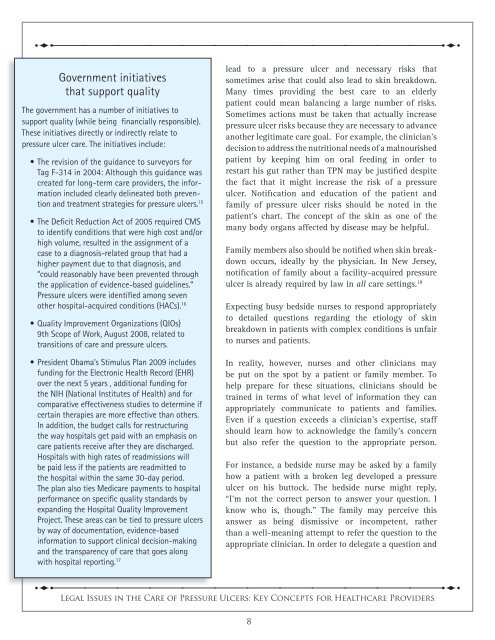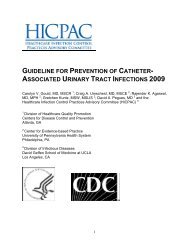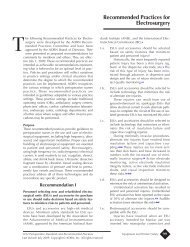Legal Issues in the Care of Pressure Ulcer Patients - Medline
Legal Issues in the Care of Pressure Ulcer Patients - Medline
Legal Issues in the Care of Pressure Ulcer Patients - Medline
You also want an ePaper? Increase the reach of your titles
YUMPU automatically turns print PDFs into web optimized ePapers that Google loves.
sttttttttttttsGovernment <strong>in</strong>itiativesthat support qualityThe government has a number <strong>of</strong> <strong>in</strong>itiatives tosupport quality (while be<strong>in</strong>g f<strong>in</strong>ancially responsible).These <strong>in</strong>itiatives directly or <strong>in</strong>directly relate topressure ulcer care. The <strong>in</strong>itiatives <strong>in</strong>clude:• The revision <strong>of</strong> <strong>the</strong> guidance to surveyors forTag F-314 <strong>in</strong> 2004: Although this guidance wascreated for long-term care providers, <strong>the</strong> <strong>in</strong>formation<strong>in</strong>cluded clearly del<strong>in</strong>eated both preventionand treatment strategies for pressure ulcers. 15• The Deficit Reduction Act <strong>of</strong> 2005 required CMSto identify conditions that were high cost and/orhigh volume, resulted <strong>in</strong> <strong>the</strong> assignment <strong>of</strong> acase to a diagnosis-related group that had ahigher payment due to that diagnosis, and“could reasonably have been prevented through<strong>the</strong> application <strong>of</strong> evidence-based guidel<strong>in</strong>es.”<strong>Pressure</strong> ulcers were identified among seveno<strong>the</strong>r hospital-acquired conditions (HACs). 16• Quality Improvement Organizations (QIOs)9th Scope <strong>of</strong> Work, August 2008, related totransitions <strong>of</strong> care and pressure ulcers.lead to a pressure ulcer and necessary risks thatsometimes arise that could also lead to sk<strong>in</strong> breakdown.Many times provid<strong>in</strong>g <strong>the</strong> best care to an elderlypatient could mean balanc<strong>in</strong>g a large number <strong>of</strong> risks.Sometimes actions must be taken that actually <strong>in</strong>creasepressure ulcer risks because <strong>the</strong>y are necessary to advanceano<strong>the</strong>r legitimate care goal. For example, <strong>the</strong> cl<strong>in</strong>ician’sdecision to address <strong>the</strong> nutritional needs <strong>of</strong> a malnourishedpatient by keep<strong>in</strong>g him on oral feed<strong>in</strong>g <strong>in</strong> order torestart his gut ra<strong>the</strong>r than TPN may be justified despite<strong>the</strong> fact that it might <strong>in</strong>crease <strong>the</strong> risk <strong>of</strong> a pressureulcer. Notification and education <strong>of</strong> <strong>the</strong> patient andfamily <strong>of</strong> pressure ulcer risks should be noted <strong>in</strong> <strong>the</strong>patient’s chart. The concept <strong>of</strong> <strong>the</strong> sk<strong>in</strong> as one <strong>of</strong> <strong>the</strong>many body organs affected by disease may be helpful.Family members also should be notified when sk<strong>in</strong> breakdownoccurs, ideally by <strong>the</strong> physician. In New Jersey,notification <strong>of</strong> family about a facility-acquired pressureulcer is already required by law <strong>in</strong> all care sett<strong>in</strong>gs. 18Expect<strong>in</strong>g busy bedside nurses to respond appropriatelyto detailed questions regard<strong>in</strong>g <strong>the</strong> etiology <strong>of</strong> sk<strong>in</strong>breakdown <strong>in</strong> patients with complex conditions is unfairto nurses and patients.• President Obama’s Stimulus Plan 2009 <strong>in</strong>cludesfund<strong>in</strong>g for <strong>the</strong> Electronic Health Record (EHR)over <strong>the</strong> next 5 years , additional fund<strong>in</strong>g for<strong>the</strong> NIH (National Institutes <strong>of</strong> Health) and forcomparative effectiveness studies to determ<strong>in</strong>e ifcerta<strong>in</strong> <strong>the</strong>rapies are more effective than o<strong>the</strong>rs.In addition, <strong>the</strong> budget calls for restructur<strong>in</strong>g<strong>the</strong> way hospitals get paid with an emphasis oncare patients receive after <strong>the</strong>y are discharged.Hospitals with high rates <strong>of</strong> readmissions willbe paid less if <strong>the</strong> patients are readmitted to<strong>the</strong> hospital with<strong>in</strong> <strong>the</strong> same 30-day period.The plan also ties Medicare payments to hospitalperformance on specific quality standards byexpand<strong>in</strong>g <strong>the</strong> Hospital Quality ImprovementProject. These areas can be tied to pressure ulcersby way <strong>of</strong> documentation, evidence-based<strong>in</strong>formation to support cl<strong>in</strong>ical decision-mak<strong>in</strong>gand <strong>the</strong> transparency <strong>of</strong> care that goes alongwith hospital report<strong>in</strong>g. 17In reality, however, nurses and o<strong>the</strong>r cl<strong>in</strong>icians maybe put on <strong>the</strong> spot by a patient or family member. Tohelp prepare for <strong>the</strong>se situations, cl<strong>in</strong>icians should betra<strong>in</strong>ed <strong>in</strong> terms <strong>of</strong> what level <strong>of</strong> <strong>in</strong>formation <strong>the</strong>y canappropriately communicate to patients and families.Even if a question exceeds a cl<strong>in</strong>ician’s expertise, staffshould learn how to acknowledge <strong>the</strong> family’s concernbut also refer <strong>the</strong> question to <strong>the</strong> appropriate person.For <strong>in</strong>stance, a bedside nurse may be asked by a familyhow a patient with a broken leg developed a pressureulcer on his buttock. The bedside nurse might reply,“I’m not <strong>the</strong> correct person to answer your question. Iknow who is, though.” The family may perceive thisanswer as be<strong>in</strong>g dismissive or <strong>in</strong>competent, ra<strong>the</strong>rthan a well-mean<strong>in</strong>g attempt to refer <strong>the</strong> question to <strong>the</strong>appropriate cl<strong>in</strong>ician. In order to delegate a question andstttttttttttts<strong>Legal</strong> <strong>Issues</strong> <strong>in</strong> <strong>the</strong> <strong>Care</strong> <strong>of</strong> <strong>Pressure</strong> <strong>Ulcer</strong>s: Key Concepts for Healthcare Providers8
















